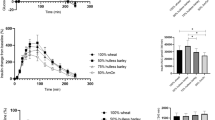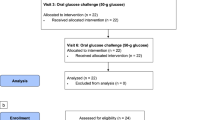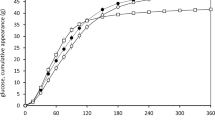Abstract
Background/objectives:
Prospective studies have shown an inverse relationship between whole grain consumption and the risk of type 2 diabetes, where short chain fatty acids (SCFA) may be involved. Our objective was to determine the effect of isolated arabinoxylan alone or in combination with whole grain rye kernels on postprandial glucose, insulin, free fatty acids (FFA), gut hormones, SCFA and appetite in subjects with the metabolic syndrome (MetS).
Subjects/methods:
Fifteen subjects with MetS participated in this acute, randomised, cross-over study. The test meals each providing 50 g of digestible carbohydrate were as follows: semolina porridge added concentrated arabinoxylan (AX), rye kernels (RK) or concentrated arabinoxylan combined with rye kernels (AXRK) and semolina porridge as control (SE). A standard lunch was served 4 h after the test meals. Blood samples were drawn during a 6-h period, and appetite scores and breath hydrogen were assessed every 30 min.
Results:
The AXRK meal reduced the acute glucose (P=0.005) and insulin responses (P<0.001) and the feeling of hunger (P=0.005; 0–360 min) compared with the control meal. The AX and AXRK meals increased butyrate and acetate concentrations after 6 h. No significant differences were found for the second meal responses of glucose, insulin, FFA, glucagon-like peptide-1 or ghrelin.
Conclusions:
Our results indicate a stimulatory effect of arabinoxylan on butyrate and acetate production, however, with no detectable effect on the second meal glucose response. It remains to be tested in a long-term study if a beneficial effect on the glucose response of the isolated arabinoxylan will be related to the SCFA production.
This is a preview of subscription content, access via your institution
Access options
Subscribe to this journal
Receive 12 print issues and online access
$259.00 per year
only $21.58 per issue
Buy this article
- Purchase on Springer Link
- Instant access to full article PDF
Prices may be subject to local taxes which are calculated during checkout



Similar content being viewed by others

References
Cornier MA, Dabelea D, Hernandez TL, Lindstrom RC, Steig AJ, Stob NR et al. The metabolic syndrome. Endocr Rev 2008; 29: 777–822.
Priebe MG, van Binsbergen JJ, de Vos R, Vonk RJ . Whole grain foods for the prevention of type 2 diabetes mellitus. Cochrane Database Syst Rev 2008; 23: CD006061.
Ye EQ, Chacko SA, Chou EL, Kugizaki M, Liu S . Greater whole-grain intake is associated with lower risk of type 2 diabetes, cardiovascular disease, and weight gain. J Nutr 2012; 142: 1304–1313.
Wirstrom T, Hilding A, Gu HF, Ostenson CG, Bjorklund A . Consumption of whole grain reduces risk of deteriorating glucose tolerance, including progression to prediabetes. Am J Clin Nutr 2013; 97: 179–187.
Hartvigsen ML, Jeppesen PB, Laerke HN, Njabe EN, Bach Knudsen KE, Hermansen K . Concentrated arabinoxylan in wheat bread has beneficial effects as rye breads on glucose and changes in gene expressions in insulin-sensitive tissues of zucker diabetic fatty (ZDF) rats. J Agric Food Chem 2013; 61: 5054–5063.
Hartvigsen ML, Gregersen S, Laerke HN, Holst JJ, Bach Knudsen KE, Hermansen K . Effects of concentrated arabinoxylan and beta-glucan compared with refined wheat and whole grain rye on glucose and appetite in subjects with the metabolic syndrome: a randomized study. Eur J Clin Nutr 2014; 68: 84–90.
Nilsson AC, Ostman EM, Granfeldt Y, Bjorck IM . Effect of cereal test breakfasts differing in glycemic index and content of indigestible carbohydrates on daylong glucose tolerance in healthy subjects. Am J Clin Nutr 2008; 87: 645–654.
Brighenti F, Benini L, Del Rio D, Casiraghi C, Pellegrini N, Scazzina F et al. Colonic fermentation of indigestible carbohydrates contributes to the second-meal effect. Am J Clin Nutr 2006; 83: 817–822.
Nilsson AC, Ostman EM, Knudsen KE, Holst JJ, Bjorck IM . A cereal-based evening meal rich in indigestible carbohydrates increases plasma butyrate the next morning. J Nutr 2010; 140: 1932–1936.
Kasprzak MM, Laerke HN, Knudsen KE . Changes in molecular characteristics of cereal carbohydrates after processing and digestion. Int J Mol Sci 2012; 13: 16833–16852.
McIntosh GH, Noakes M, Royle PJ, Foster PR . Whole-grain rye and wheat foods and markers of bowel health in overweight middle-aged men. Am J Clin Nutr 2003; 77: 967–974.
Bach Knudsen KE, Serena A, Kjaer AK, Jorgensen H, Engberg R . Rye bread enhances the production and plasma concentration of butyrate but not the plasma concentrations of glucose and insulin in pigs. J Nutr 2005; 135: 1696–1704.
Giacco R, Della Pepa G, Luongo D, Riccardi G . Whole grain intake in relation to body weight: from epidemiological evidence to clinical trials. Nutr Metab Cardiovasc Dis 2011; 21: 901–908.
Wanders AJ, van den Borne JJ, de Graaf C, Hulshof T, Jonathan MC, Kristensen M et al. Effects of dietary fibre on subjective appetite, energy intake and body weight: a systematic review of randomized controlled trials. Obes Rev 2011; 12: 724–739.
Mohlig M, Koebnick C, Weickert MO, Lueder W, Otto B, Steiniger J et al. Arabinoxylan-enriched meal increases serum ghrelin levels in healthy humans. Horm Metab Res 2005; 37: 303–308.
Lu ZX, Walker KZ, Muir JG, Mascara T, O'Dea K . Arabinoxylan fiber, a byproduct of wheat flour processing, reduces the postprandial glucose response in normoglycemic subjects. Am J Clin Nutr 2000; 71: 1123–1128.
Garcia AL, Otto B, Reich SC, Weickert MO, Steiniger J, Machowetz A et al. Arabinoxylan consumption decreases postprandial serum glucose, serum insulin and plasma total ghrelin response in subjects with impaired glucose tolerance. Eur J Clin Nutr 2007; 61: 334–341.
Garcia AL, Steiniger J, Reich SC, Weickert MO, Harsch I, Machowetz A et al. Arabinoxylan fibre consumption improved glucose metabolism, but did not affect serum adipokines in subjects with impaired glucose tolerance. Horm Metab Res 2006; 38: 761–766.
Lu ZX, Walker KZ, Muir JG, O'Dea K . Arabinoxylan fibre improves metabolic control in people with Type II diabetes. Eur J Clin Nutr 2004; 58: 621–628.
Alberti KG, Zimmet P, Shaw J, IDF Epidemiology Task Force Consensus Group. The metabolic syndrome—a new worldwide definition. Lancet 2005; 366: 1059–1062.
Flint A, Raben A, Blundell JE, Astrup A . Reproducibility, power and validity of visual analogue scales in assessment of appetite sensations in single test meal studies. Int J Obes Relat Metab Disord 2000; 24: 38–48.
Hansen B . Determination of nitrogen as elementary-N, an alternative to Kjeldahl. Acta Agric Scand 1989; 39: 113–118.
Stoldt W . Vorschlag zur Vereinheitlichung der Fettbestimmung in Lebensmitteln. Fette und Seifen 1952; 54: 206–207.
Larsson K, Bengtsson S Bestämming av lättilgängeliga kolhydrater i växtmaterial (Determination of readily available carbohydrates in plant material). National Laboratory of Agricultural Chemistry Methods Report no. 22. National Laboratory of Agricultural Chemistry: Uppsala, 1983.
Bach Knudsen KE . Carbohydrate and lignin contents of plant materials used in animal feeding. Anim Feed Sci Technol 1997; 67: 319–338.
Theander O, Aman P . Studies on dietary-fibers.1. Analysis and chemical characterization of water-soluble and water-insoluble dietary-fibers. Swed J Agric Res 1979; 9: 97–106.
Kasprzak MM, Laerke HN, Knudsen KE . Effects of isolated and complex dietary fiber matrices in breads on carbohydrate digestibility and physicochemical properties of ileal effluent from pigs. J Agric Food Chem 2012; 60: 12469–12476.
Orskov C, Rabenhoj L, Wettergren A, Kofod H, Holst JJ . Tissue and plasma concentrations of amidated and glycine-extended glucagon-like peptide I in humans. Diabetes 1994; 43: 535–539.
Brighenti F . Summary of the conclusion of the working group on profibre interlaboratory study on determination of short chain fatty acids in blood. In: Gullion F, Amadò R, Amaral-Collaco MT, Andersson H, Asp NG, Bach Knudsen KE, Champ M, Mathers J, Robertson JA, Rowland I, Van Loo J (eds). Functional Properties of Non-digestible Carbohydrates. European Commission, DG XII, Science, Research and Development: Brussels, Belgium, 1998, pp 150–153.
Rakha A, Aman P, Andersson R . How does the preparation of rye porridge affect molecular weight distribution of extractable dietary fibers? Int J Mol Sci 2011; 12: 3381–3393.
Jenkins DJ, Wolever TM, Taylor RH, Griffiths C, Krzeminska K, Lawrie JA et al. Slow release dietary carbohydrate improves second meal tolerance. Am J Clin Nutr 1982; 35: 1339–1346.
Liljeberg HG, Akerberg AK, Bjorck IM . Effect of the glycemic index and content of indigestible carbohydrates of cereal-based breakfast meals on glucose tolerance at lunch in healthy subjects. Am J Clin Nutr 1999; 69: 647–655.
Tarini J, Wolever TM . The fermentable fibre inulin increases postprandial serum short-chain fatty acids and reduces free-fatty acids and ghrelin in healthy subjects. Appl Physiol Nutr Metab 2010; 35: 9–16.
Nilsson A, Granfeldt Y, Ostman E, Preston T, Bjorck I . Effects of GI and content of indigestible carbohydrates of cereal-based evening meals on glucose tolerance at a subsequent standardised breakfast. Eur J Clin Nutr 2006; 60: 1092–1099.
Gråsten S, Liukkonen K, Chrevatidis A, El-Nezami H, Poutanen K, Mykkänen H . Effects of wheat pentosan and inulin on the metabolic activity of fecal microbiota and on bowel function in healthy humans. Nutr Res 2003; 23: 1503–1514.
Glitsø L, Gruppen H, Schols H, Højsgaard S, Sandström B, Bach Knudsen K . Degradation of rye arabinoxylans in the large intestine of pigs. J Sci Food Agric 1999; 79: 961–969.
Juntunen KS, Niskanen LK, Liukkonen KH, Poutanen KS, Holst JJ, Mykkanen HM . Postprandial glucose, insulin, and incretin responses to grain products in healthy subjects. Am J Clin Nutr 2002; 75: 254–262.
Juntunen KS, Laaksonen DE, Autio K, Niskanen LK, Holst JJ, Savolainen KE et al. Structural differences between rye and wheat breads but not total fiber content may explain the lower postprandial insulin response to rye bread. Am J Clin Nutr 2003; 78: 957–964.
Rosen LA, Silva LO, Andersson UK, Holm C, Ostman EM, Bjorck IM . Endosperm and whole grain rye breads are characterized by low post-prandial insulin response and a beneficial blood glucose profile. Nutr J 2009; 8: 42–52.
Rosen LA, Ostman EM, Shewry PR, Ward JL, Andersson AA, Piironen V et al. Postprandial glycemia, insulinemia, and satiety responses in healthy subjects after whole grain rye bread made from different rye varieties 1. J Agric Food Chem 2011; 59: 12139–12148.
van Loon LJ, Kruijshoop M, Menheere PP, Wagenmakers AJ, Saris WH, Keizer HA . Amino acid ingestion strongly enhances insulin secretion in patients with long-term type 2 diabetes. Diabetes Care 2003; 26: 625–630.
Thorburn A, Muir J, Proietto J . Carbohydrate fermentation decreases hepatic glucose output in healthy subjects. Metabolism 1993; 42: 780–785.
Lejeune MP, Westerterp KR, Adam TC, Luscombe-Marsh ND, Westerterp-Plantenga MS . Ghrelin and glucagon-like peptide 1 concentrations, 24-h satiety, and energy and substrate metabolism during a high-protein diet and measured in a respiration chamber. Am J Clin Nutr 2006; 83: 89–94.
Mansour A, Hosseini S, Larijani B, Pajouhi M, Mohajeri-Tehrani MR Nutrients related to GLP1 secretory responses. Nutrition 2013; 29: 813–820.
Freeland KR, Wilson C, Wolever TM . Adaptation of colonic fermentation and glucagon-like peptide-1 secretion with increased wheat fibre intake for 1 year in hyperinsulinaemic human subjects. Br J Nutr 2010; 103: 82–90.
Cherbut C . Motor effects of short-chain fatty acids and lactate in the gastrointestinal tract. Proc Nutr Soc 2003; 62: 95–99.
Nilsson AC, Ostman EM, Holst JJ, Bjorck IM . Including indigestible carbohydrates in the evening meal of healthy subjects improves glucose tolerance, lowers inflammatory markers, and increases satiety after a subsequent standardized breakfast. J Nutr 2008; 138: 732–739.
Rolls BJ, Castellanos VH, Halford JC, Kilara A, Panyam D, Pelkman CL et al. Volume of food consumed affects satiety in men. Am J Clin Nutr 1998; 67: 1170–1177.
Acknowledgements
The study was supported by The Danish Council for Strategic Research (DSF 2101–08–0068), the Nordic Centre of Excellence Programme on Food, Nutrition and Health, NordForsk (SYSDIET; 070014) and NNF Center for Basic Metabolic Research, Department of Biomedical Sciences, University of Copenhagen. We thank Manildra Group Ltd and Lantmännen Food R&D for the arabinoxylan and ingredients for the porridge. Furthermore, we thank Tove Skrumsager and Lene Trudsø for excellent technical assistance and Kia Valum Rasmussen for dietetic assistance.
Author information
Authors and Affiliations
Corresponding author
Ethics declarations
Competing interests
The authors declare no conflict of interest.
Rights and permissions
About this article
Cite this article
Hartvigsen, M., Lærke, H., Overgaard, A. et al. Postprandial effects of test meals including concentrated arabinoxylan and whole grain rye in subjects with the metabolic syndrome: a randomised study. Eur J Clin Nutr 68, 567–574 (2014). https://doi.org/10.1038/ejcn.2014.25
Received:
Revised:
Accepted:
Published:
Issue Date:
DOI: https://doi.org/10.1038/ejcn.2014.25
This article is cited by
-
Chronic consumption of a blend of inulin and arabinoxylan reduces energy intake in an ad libitum meal but does not influence perceptions of appetite and satiety: a randomised control-controlled crossover trial
European Journal of Nutrition (2023)
-
Elucidating the role of the gut microbiota in the physiological effects of dietary fiber
Microbiome (2022)
-
Whole grain food diet slightly reduces cardiovascular risks in obese/overweight adults: a systematic review and meta-analysis
BMC Cardiovascular Disorders (2020)
-
Lipid Lowering with Soluble Dietary Fiber
Current Atherosclerosis Reports (2016)


